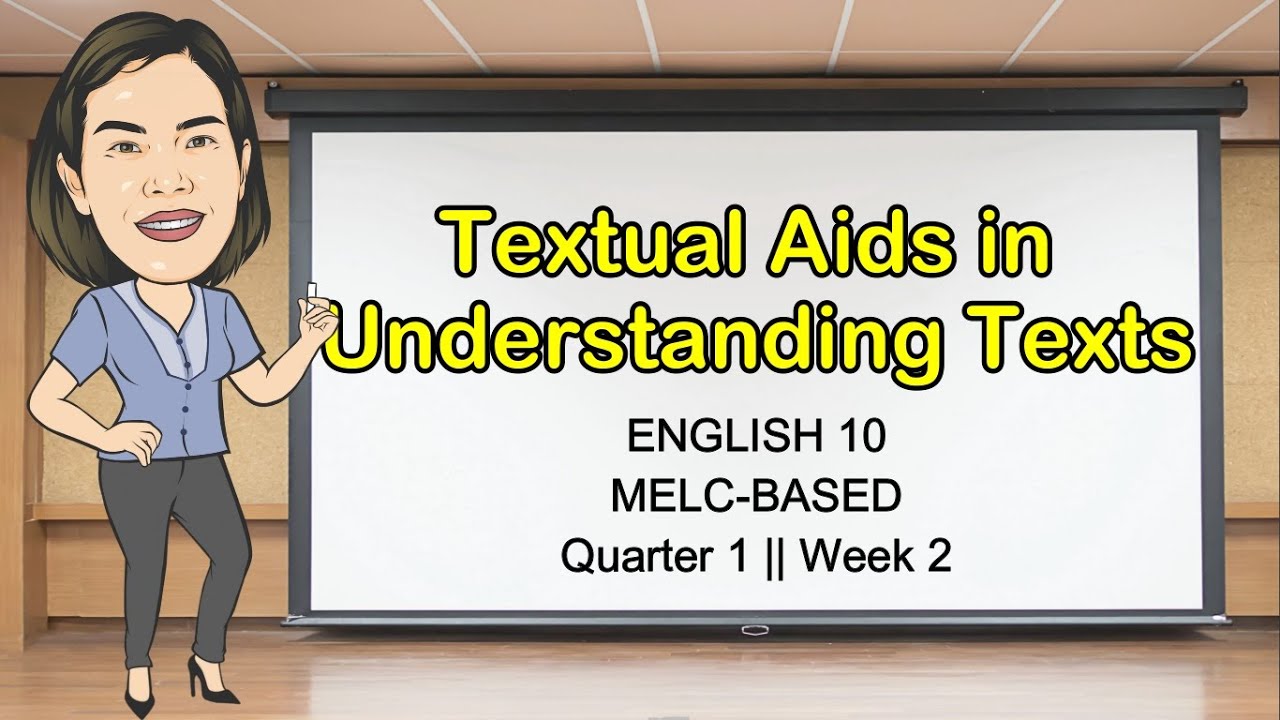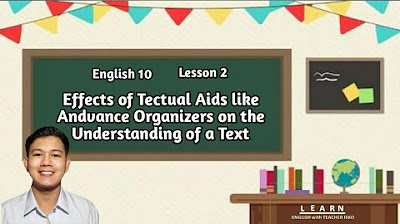English 10 | Quarter 1 | Week 2 Textual Aids in Understanding Text
Summary
TLDRThis video discusses the importance of textual aids in enhancing comprehension. Textual aids, such as visual elements like diagrams and charts, help readers grasp key ideas and focus on essential information. The video explains the difference between linear and non-linear texts, with examples of graphic organizers, Venn diagrams, process charts, and more. It also outlines steps to convert linear texts into non-linear formats, emphasizing simplicity and clarity. Tips for creating effective textual aids include using images, highlighting important details, and making content visually appealing to readers.
Takeaways
- 📚 Textual aids are visual elements that combine text with pictures, drawings, lines, and shapes to make reading more appealing.
- 🔍 They help readers understand content, focus on important parts, identify key information, and preview texts.
- 📈 Textual aids can provide a graphic presentation of words and numbers, aiding in comprehension.
- 📖 There are two types of texts: linear (like stories and educational texts) and non-linear (like graphic organizers and charts).
- 📊 Examples of textual aids include Venn diagrams, process charts, T-charts, and graphic charts.
- 🛠️ To turn linear text into non-linear, start by identifying the main idea, then extract important information and keywords.
- ✂️ Classify the information into categories and choose the correct non-linear text format to present it.
- 🎨 Enhance textual aids by using photos, drawings, highlighting numbers, and employing different colors for emphasis.
- 🍰 A practical example is provided, demonstrating how to create a process chart for baking a cake from a linear text description.
- 💡 Tips for improving textual aids include making them visually appealing and ensuring they effectively summarize the text.
Q & A
What are textual aids and how do they benefit readers?
-Textual aids are visual elements that combine text with pictures, drawings, lines, and shapes to make content more appealing. They help readers understand content, focus on important parts, identify key information, provide additional context, and preview texts.
What is the difference between linear and non-linear text?
-Linear text includes short stories, novels, letters, and educational texts, with words arranged from left to right, focusing on grammar and style. Non-linear text, such as graphic organizers, concept maps, pictures, and charts, combines text with visual elements.
Can you provide examples of textual aids mentioned in the script?
-Examples of textual aids include a Venn diagram comparing modular versus online learning, a process chart explaining module distribution, a T-chart showing advantages and disadvantages of online learning, and a graphic chart displaying enrollment data.
What are the steps to turn linear text into non-linear text?
-The steps include: 1) Reading the text and getting the main idea, 2) Identifying important information for visual presentation, 3) Using keywords and phrases, 4) Classifying information into categories, and 5) Using the correct non-linear text to present the information.
How can a process chart be created from a text about baking a cake?
-To create a process chart for baking a cake, one should first identify important steps such as mixing, baking, frosting, and finishing. Then, these steps are visually represented in a chart format to summarize the process.
What is the main idea presented in the example of linear text about learning delivery modalities?
-The main idea is 'learning delivery modalities,' which encompasses various types of learning methods such as face-to-face, distance, modular, online, TV, radio, blended, and homeschooling.
How can keywords be used to describe different types of learning delivery modalities?
-Keywords can succinctly describe each modality, such as 'face-to-face' for physically present learning, 'distance learning' for geographically remote education, 'modular' for print or digital formats, 'online' for internet-based learning, and 'blended' for a combination of face-to-face with other methods.
What additional tips are suggested to improve textual aids?
-To enhance textual aids, one can use photos or drawings, highlight important numbers, and employ different colors to emphasize information, ensuring the text is appealing and informative.
Why is it important to focus on important information when creating textual aids?
-Focusing on important information ensures that the textual aid is concise and directly communicates the key points, making it easier for readers to grasp the essential concepts without being overwhelmed by unnecessary details.
How do textual aids assist in the comprehension of complex topics?
-Textual aids assist by breaking down complex information into visually organized and simplified forms, making it easier for readers to digest and understand the content by providing a clear structure and highlighting the most relevant data.
Outlines

Esta sección está disponible solo para usuarios con suscripción. Por favor, mejora tu plan para acceder a esta parte.
Mejorar ahoraMindmap

Esta sección está disponible solo para usuarios con suscripción. Por favor, mejora tu plan para acceder a esta parte.
Mejorar ahoraKeywords

Esta sección está disponible solo para usuarios con suscripción. Por favor, mejora tu plan para acceder a esta parte.
Mejorar ahoraHighlights

Esta sección está disponible solo para usuarios con suscripción. Por favor, mejora tu plan para acceder a esta parte.
Mejorar ahoraTranscripts

Esta sección está disponible solo para usuarios con suscripción. Por favor, mejora tu plan para acceder a esta parte.
Mejorar ahoraVer Más Videos Relacionados

TEXTUAL AIDS || Grade10|| MELC-based VIDEO LESSON | QUARTER 1| MODULE 2

TEXTUAL AIDS IN UNDERSTANDING TEXTS || Quarter 1 Week 2 || English 10 || MELC-BASED || Aizie Dumuk

TEXTUAL AIDS || GRADE 10 || MELC-based VIDEO LESSON | QUARTER 1 | Module 2

Textual Aids - English 10 - Lesson 2

Grade 10 English Q1 Ep4: Textual Aids

How I'm using NotebookLM to power up my language learning
5.0 / 5 (0 votes)
